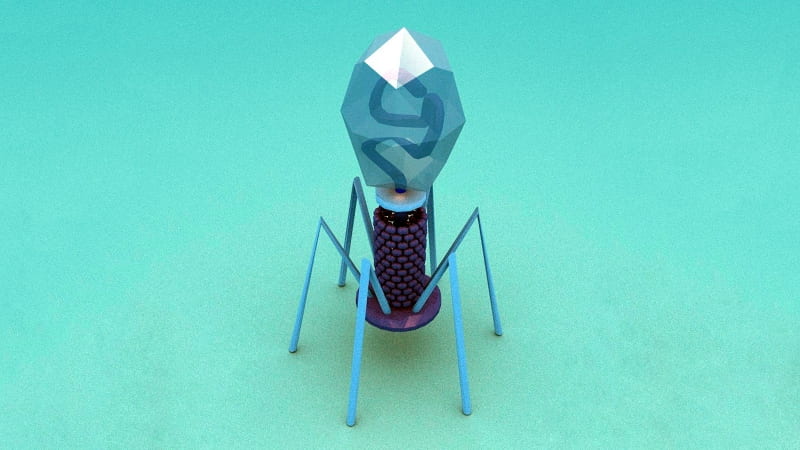VIRUSES: A FORCE OF NATURE
By: Carolyn Wilke

This is a 3D rendering of a bacteriophage, a virus that infects and replicates within a bacterium. Oona Räisänen/WIKIMEDIA COMMONS
Viruses are capable of creating havoc. Sometimes when I think about viruses, I get a picture of a massive outbreak. Usually this picture isn’t the nearly apocalyptic public health nightmare that’s depicted in the movie “Contagion,” but it’s still pretty scary. This disease causing aspect of viruses is compelling. However, because of my microbiology class, I’m now just as likely to think of the ways these strange non-living entities act as an environmental force of nature to influence microbial diversity.
While the most familiar viruses cause disease in humans, there are viruses that infect organisms at every scale, from plants and animals all the way down to microbes. By preying on other creatures, viruses play a role in natural selection. This selection is of great importance on the microbial level because of the huge quantity of viruses that exist in the environment.
In the aquatic ecosystems that have been studied, viruses have a greater abundance than bacteria by a ratio of roughly 10 to 1. And, overall, viruses may outnumber all other biological forms on earth. Some of this viral “grazing” impacts systems that we can observe—for example one research group recently found that viruses contribute to the demise of algal blooms, growths of photosynthesizing organisms on the surfaces of seas or freshwaters that can span thousands of miles.
The way that viruses attack bacterial cells is also important in their shaping of microbial diversity. One of the ways viruses kill cells is by breaking open the cell membrane, or “lysing” the cells. In bacterial cells, the genetic material is not enclosed in a nuclear membrane of its own, so when a virus lyses this type of cell, the DNA is released from the cell and into the environment.
Bacteria have the ability to take up DNA from the environment and incorporate it into their own genomes. By way of lysing cells, viruses take part in this process of passing around DNA through non-reproductive means, which is called horizontal gene transfer. Interestingly, the DNA that a bacterium can acquire through horizontal gene transfer can confer new abilities (such as antibiotic resistance) that can impact the genetic diversity of a microbial community.
The nature of individual types of viruses also affects the structure of a microbial community. The selectivity that a virus can have for a particular type of host affects the turnover dynamics of bacterial populations. Some types of viruses can coexist with the host for long periods of time in a relationship that is parasitic, while others kill the cell more quickly after infection. Some viruses even employ a strategy called “killing the winner”, in which they specifically target the most abundant bacterial populations. This can lead to cycles of rapid growth and decline for both the viruses and the preyed-upon bacteria.
While viruses can cause great harm, they also play a role that often goes entirely unnoticed. Like a shallow stream rolling through a canyon or t
